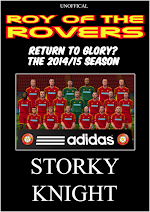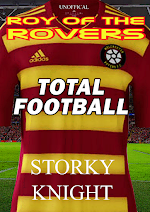The ground was completely rebuilt in the 1930s, with the addition of a magnificent art deco grandstand. The West Stand included a grand entrance hall complete with marble floors and staircases. The trophy room, offices and changing rooms were all housed in the iconic stand that is still part of the modern stadium today.
Unlike any other ground in the country at the time Melchester Stadium had three large two-tiered covered stands. The huge open terrace at the south end of the ground provides this fantastic view of the best stadium in the country at the time. From the image it is clear that the West Stand (left) is larger than the East opposite. The north and south ends were curved.
In the early 60s, Melchester Stadium was already beginning to age and when local rivals Shermall Athletic built a state of the art super stadium just across the River Mel the Rovers board eventually made the decision to improve their own ground. Rovers had spent part of the 1960-61 season playing at Shermall Stadium and the players appreciated the comfort of a modern stadium. Both grounds are shown in the image on the right as Roy and pals ride in a helicopter during that fateful 60-61 season.
The stadium upgrade was completed in time for the start of the 1961-62 season. The capacity was increased to a staggering 85,000 as the north and south ends were replaced with a huge towering covered terrace at the North end which brought the fans much closer to the pitch. Granite Hill, the huge open terrace remained at the South end. The famous West Stand gained a sponsor in the Daily Mirror newspaper. The East Stand double tiered stand was torn down and a much larger single tier terrace with complete coverage built in its place.
 |
| The new East Stand in 1961-62 vs Schonved |
Disaster struck in November 1964 when during a First Division match with Silford Athletic the pitch began to crack up. Giant holes appeared and Rovers would have to leave their inspirational stadium until the subsidence could be fixed. During this time Rovers played at the haunted Pelfield Stadium that millionaire new forward Jumbo Trudgeon had bought for them. Repairs were completed and Rovers returned home in February 1965.
 |
| The Mel Park pitch subsides for the first time (1964) |
Not much changed at Melchester Stadium until the 1977-78 season. After spending the summer playing in the US, Roy returned with the idea of installing big closed circuit TV screens behind each goal. Replays of goals were to be shown in an attempt to curb the rise of hooliganism. The stadium now had a capacity of around 50,000.
 |
| Big screens were installed early in the 1977-78 season |
With hooliganism becoming a real problem throughout English football, Melchester Rovers led the way in innovative ways to try and combat the thugs. The big screens hadn't really worked, but Roy in particular was not keen on flooding the ground with policemen or perimeter fencing. So in 1982 the club became the first to convert their stadium into an all-seater arena. The stadium was completely refurbished with red brick stand enclosing the field. The charm of the original Melchester Stadium appeared lost.
 |
| Roy examines the architects plans for the 1982 redevelopment of the stadium |
During the opening fixture of the 1988-89 season against Blackport Rovers it was deja-vu for Roy and Blackie as the Mel Park pitch once again sagged beneath their feet. This time the pitch subsidence was blamed on works on the Melchester underground subway. Rovers made the decision to play their home matches at Wembley while repairs were made. Mel Park eventually reopened in February 1989.
 |
| Mel Park is officially reopened in February 1989 |
That was the last major upgrade on the famous stadium. New coloured seating was added and club initials later added to the East Stand. However, by the turn of the Millennium it was clear that the historic stadium needed significant improvements.
 |
| Mel Park in the 90s with the incorrect caption stating Rovers had occupied the same site since formation |
Plans for a magnificent ultra-modern stadium were drawn up and demolition of the old stadium began in the autumn of 2000. The final match played at the famous old ground was due to be the Champions League match with Rapid Alkmar. However, while all but the famous West Stand were torn down, the new stadium was never built and Rovers eventually returned to a new Mel Park, with the iconic grandstand still standing today.
 |
| Mel Park's iconic West Stand is still standing today (2019) |






















2 Comments
What a great article !!!!!
ReplyDeleteGreat stuff
ReplyDelete